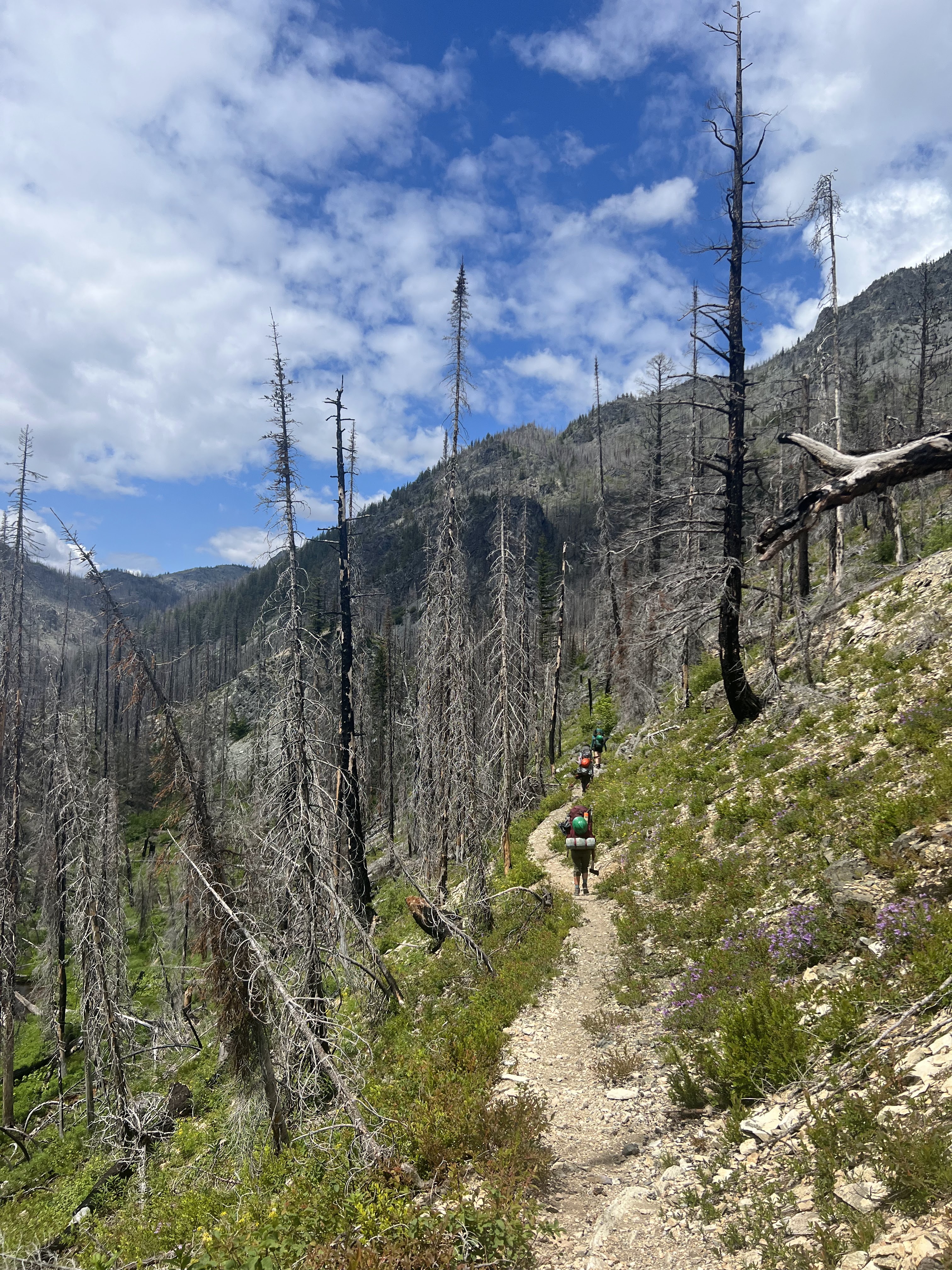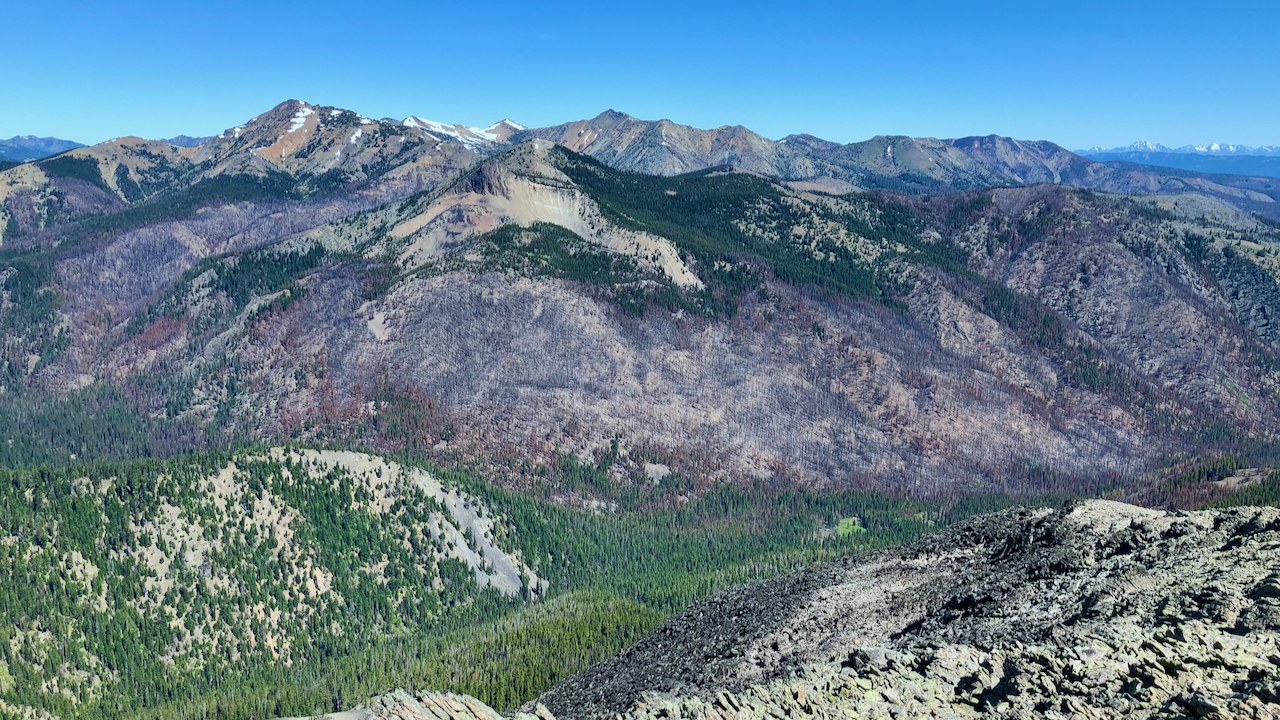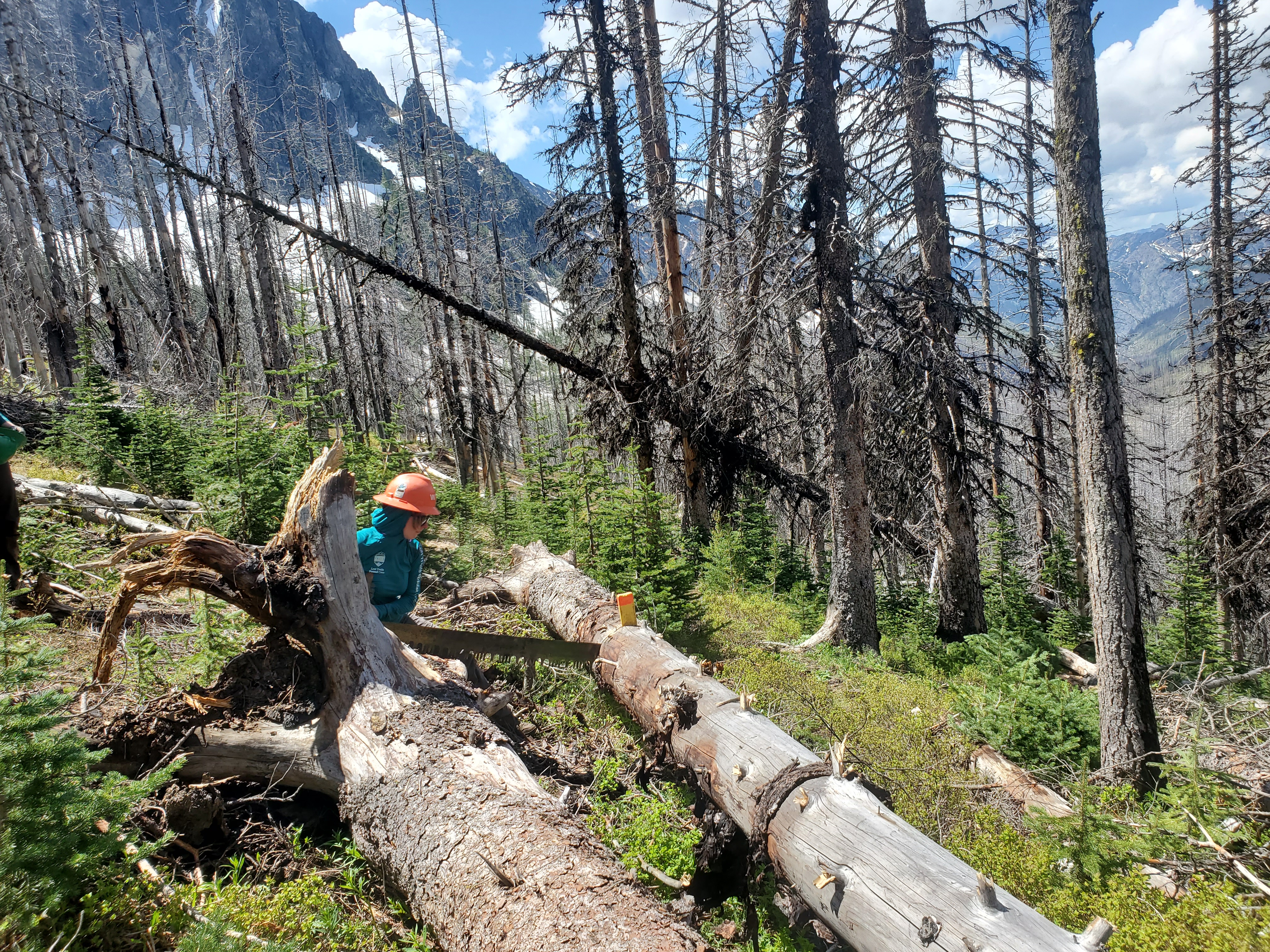Wildfires Damage Backcountry Trails. Here's Where WTA Is Helping Restore Them.
With wildfires burning bigger and hotter across remote areas of Washington, WTA's Lost Trails Found campaign commits year-after-year to restoring and rebuilding resilient trail networks in areas like the Pasayten Wilderness, the Entiat Wilderness and — now — an area of the Naches Ranger District east of Mount Rainier.
Washington is home to some stunning, and incredibly varied, backcountry. From the open rolling tundra in the Pasayten Wilderness to the forested mountains of the William O. Douglas Wilderness, these trails offer hikers and backpackers unique experiences ranging from a quiet day hike to week-long backpacking trips.
 The WTA Lost Trails Crew hikes through one of many old wildfire burns in the Pasayten Wilderness, an area of Washington beloved for its beauty and rugged character. Photo by Savanna Lopez.
The WTA Lost Trails Crew hikes through one of many old wildfire burns in the Pasayten Wilderness, an area of Washington beloved for its beauty and rugged character. Photo by Savanna Lopez.
The terrain is often rugged and remote, which is part of the appeal. It's also part of the challenge of maintaining these trails. They're hard to reach, and take dedicated time and resources to maintain with any regularity. When you add wildfires into the mix, dozens or even hundreds of miles of trail can become inaccessible in a single season.
For years, WTA has focused our Lost Trails Found campaign on keeping these remote trails from disappearing entirely. Working in partnership with other trail organizations, with overstretched land managers charged with stewarding these trails, and with volunteers, we've been restoring trails made impassable by fire. Wildfires play an important role in wilderness ecosystems, but as climate change drives them to burn hotter and bigger, the impact on trails will only increase.
This summer and fall, in addition to a handful of Backcountry Response Team volunteer crews, we put two professional trail crews into the field. A good portion of their work was focused on reopening trails impacted by wildfire.
After the Schneider Springs Fire, Digging in on the Naches Ranger District
In a new collaboration with the U.S. Forest Service, WTA signed an agreement with the Naches Ranger District to put our Lost Trails Found crews to work opening up 50 miles of trails by the end of 2024. From June to mid-October, our crews have been working in the Schneider Springs burn zone clearing trails of downed logs and restoring trail tread.
The Schneider Springs fire, which started from a lightning storm in August of 2021, burned over 100,000 acres of National Forest Service and Washington Department of Natural Resources land. Fires bring trees down over trails, destroy infrastructure like bridges and degrade trail stability for years. Even before the fire, there had been significant maintenance needs in the area, a problem created and compounded by massive funding and staffing shortfalls in land manager budgets.

A 2022 look at the Bismark, Nelson Ridge, Mt Aix conglomeration and the aftermath of the 2021 Schneider Springs Fire. Photo by trip reporter urbanfarmboy.
In 2019, trip reporter and WTA member Walkin' Fool had this to say about a 3-day backpacking trip they planned along the Burnt Mountain, Rattlesnake and Shellrock Peak trails:
"Some parts of trails non-existent or in terrible condition. Loop not recommended unless you love route-finding and bushwhacking."
Over the last few months, our Lost Trails Found crews spent more than 3,000 hours clearing hundreds of logs, restoring tread and maintaining roughly 25 miles of trails across the William O. Douglas Wilderness and adjacent areas in the Naches Ranger District. They worked on well-known trails like Mount Aix as well as some lesser-known area trails and rugged loops that included the Burnt Mountain Trail, Ironstone Mountain Trail, Nile Ridge Trail, Rattlesnake Creek Trail and Soda Springs Trail.

The Lost Trails crew cuts and rolls a giant log off trail on their trip to improve the American Ridge and Nile Creek trails. Photo by Kyvan Elep.
 A Lost Trails Crew member cuts a log to clear a trail on a late September hitch along the MJB/Burnt Mountain Loop in the Naches Ranger District. Photo by Kyvan Elep.
A Lost Trails Crew member cuts a log to clear a trail on a late September hitch along the MJB/Burnt Mountain Loop in the Naches Ranger District. Photo by Kyvan Elep.
Returning to the Entiat and Pasayten & future-proofing for fires
WTA and many, many volunteers have worked in the Entiat Wilderness for years, but in the last several years, our Lost Trails crews have done incredible work (along with forest service trail crews) to help recover trails and connect loop options. After a wildfire, trees will come down for years and even decades later, meaning that even after a big push to restore a trail system, it's important to return for annual maintenance to keep the remote trails viable.
This year, our Lost Trails crews worked clearing and addressing erosion on parts of the Cow Creek, the Larch Lakes, the Snowy Brushy Creek and Entiat River Trails. Two WTA Backcountry Response Team volunteer trail crews also worked here this summer.
"Since the Wolverine Fire in 2015, this was the first year Snow Brushy Creek Trail has been logged out to Milham Pass, thanks to the LTF crew," Sam Zook, Entiat Ranger District Trails Coordinator, Okanogan-Wenatchee National Forest. "As time passes, the positive impacts of LTF’s work will continue to be felt, as the trails recover from the Wolverine Fire’s aftermath. With LTF’s ongoing support, we can plan focused maintenance efforts, addressing issues like drainage issues, reinforcing structures, and maintaining proper trail clearing. The importance of such maintenance cannot be overstated, as it prevents resource damage caused by users going off-trail to circumvent obstacles, particularly in post-burn areas."
Annual maintenance of trail networks and loops through old burns does more than just enhance the backpacking and long trail running options; it creates trail systems more resilient to future fires. More viable trails can serve hikers evacuating a fire as well as firefighting crews who might need to reach an area. If part of a trail system burns, those recently-cleared trails offer a way in to address remote tangles.

The Lost Trails Found crew cut and removed 180 logs from the Snowy Brushy Trail in the Entiat. Photo by Zachary Sklar.
Our Lost Trails and volunteer crews also returned to the Pasayten, where we've been working and building partnerships for years. The Pasayten has decades of older wildfire burns. In older burns where vegetation and brilliant fields of wildflowers are blooming, trees can come down for many, many years after a wildfire burn, leading to jackstraw piles of logs large and small. WTA volunteers who have spent their spring and summer vacations working on in the Pasayten have likely worked on trails that run through old burns.
A crew of Backcountry Response Team volunteers and the Lost Trails crew worked on the Hidden Lakes Trail this year, the Lost Trails crew picked up where a Back Country Horseman crew left off in June. They still had plenty of work cut out of them.
"The log load was very heavy," the Lost Trails crew reported back in the understatement of the summer. In a single week, they cut and removed more than 471 logs and countless piles of smaller wood from the trail.
 The Lost Trails Found crew made their time in the Pasayten count by coordinating with our partner organization and removing 471 logs in a single week. Photo by Zackary Sklar.
The Lost Trails Found crew made their time in the Pasayten count by coordinating with our partner organization and removing 471 logs in a single week. Photo by Zackary Sklar.
One of the Lost Trails crews even logged a week to clear some of the downed logs from a 2017 fire that impacted the iconic Shedroof Divide Trail in the northeast corner of the state.
Trail restoration: a critical piece in planning for the future
Washington state has some spectacular and remote trail experiences, but they aren't guaranteed.
As climate change amplifies the impacts of wildfires and erosion, trails are falling into disrepair. But if post-fire funding resources can be coordinated across thriving partnerships, we can leave trail systems more resilient after a fire than they were before. And if we can find the will for federal and state funding and ongoing annual maintenance needs, then we can help keep them that way for decades to come.



Comments